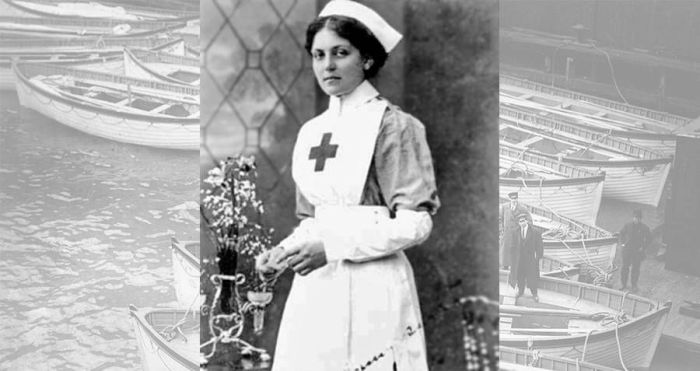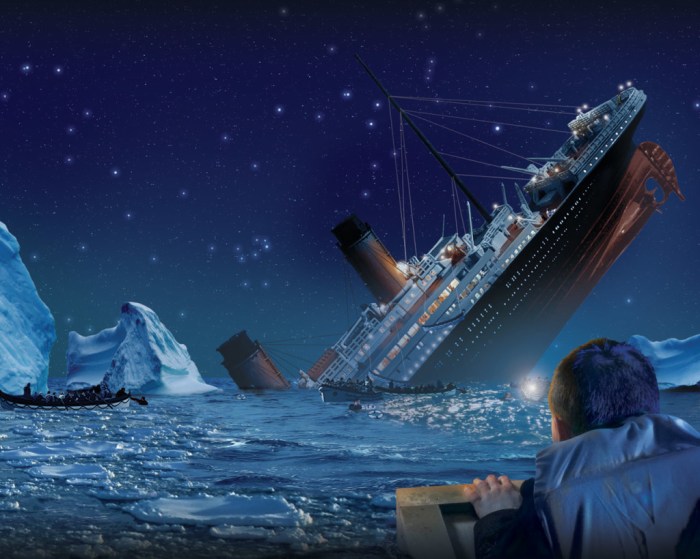I survived the sinking of the Titanic. The ship of dreams turned into a nightmare on that fateful night in 1912. In this narrative, I will share my firsthand account of the tragedy, the emotional and psychological impact it had on me, and the lessons I learned from that harrowing experience.
The content of the second paragraph that provides descriptive and clear information about the topic
Titanic’s Sinking

The sinking of the RMS Titanic on April 15, 1912, remains one of the most infamous maritime disasters in history. The British passenger liner was on its maiden voyage from Southampton, England, to New York City, United States, when it struck an iceberg in the North Atlantic Ocean.
The collision caused the Titanic’s hull to rupture, allowing seawater to flood the ship’s compartments. Despite efforts to contain the damage, the ship sank in less than three hours, resulting in the deaths of over 1,500 people.
Causes of the Sinking
The sinking of the Titanic was a complex event with multiple contributing factors:
- Excessive Speed:The Titanic was traveling at a relatively high speed when it struck the iceberg, increasing the force of the impact.
- Lack of Lifeboats:The Titanic had insufficient lifeboats for all of its passengers and crew, leading to a shortage of evacuation capacity.
- Inadequate Compartmentalization:The Titanic’s hull was divided into 16 watertight compartments, but the bulkheads did not extend to the top of the ship, allowing water to flood multiple compartments.
- Failure to Receive Iceberg Warnings:The Titanic received several iceberg warnings before the collision, but these were not properly relayed to the ship’s captain.
Sequence of Events
The sequence of events leading to the sinking of the Titanic can be summarized as follows:
- April 10, 1912:The Titanic departs from Southampton, England.
- April 14, 1912:The Titanic receives multiple iceberg warnings.
- April 15, 1912, 11:40 PM:The Titanic strikes an iceberg.
- April 15, 1912, 12:45 AM:The Titanic sinks.
Survivor Accounts

The sinking of the Titanic left an immeasurable impact on the lives of its survivors. Their firsthand accounts provide a vivid and harrowing glimpse into the tragedy, revealing the emotional and psychological toll it took on those who lived through it.
Emotional Impact
Survivors described a range of intense emotions in the aftermath of the sinking, including shock, disbelief, guilt, and grief. The suddenness and magnitude of the disaster left many in a state of numbness, struggling to comprehend the loss of loved ones and the destruction of their dreams.
Psychological Impact
In addition to the emotional trauma, survivors also experienced significant psychological consequences. Many developed post-traumatic stress disorder (PTSD), characterized by flashbacks, nightmares, and anxiety. The experience of being on a sinking ship, facing imminent death, and witnessing the loss of others left an enduring scar on their psyches.
Long-Term Effects
The psychological impact of the Titanic’s sinking extended far beyond the immediate aftermath. Survivors carried the emotional and psychological wounds of the tragedy for the rest of their lives. Many struggled with depression, anxiety, and relationship difficulties. The disaster had a profound impact on their sense of safety and trust in the world.
Heroism and Sacrifice: I Survived The Sinking Of The Titanic
The sinking of the Titanic witnessed countless acts of heroism and selflessness, as individuals risked their lives to save others.One notable act of heroism was performed by the ship’s captain, Edward Smith. Despite being fully aware of the impending danger, Smith remained on the bridge, directing evacuation efforts and ensuring the safety of passengers and crew.
His unwavering commitment to duty cost him his life, as he went down with the ship.Another example of selflessness was displayed by Thomas Andrews, the ship’s designer. Andrews tirelessly worked throughout the night to assess the damage and provide assistance.
He prioritized the safety of others, urging passengers to board lifeboats even as his own life hung in the balance.
Sacrifices of the Crew
The crew of the Titanic also exhibited remarkable heroism. Firemen and engineers stayed below deck, working tirelessly to maintain power and keep the ship afloat. Many of them perished in the line of duty, sacrificing their lives to give others a chance to survive.Stewards
and stewardesses went above and beyond their roles, assisting passengers with evacuation and providing comfort in the face of adversity. Some even gave up their own life jackets to save others.
Motivations and Consequences
The motivations behind these acts of heroism varied. For some, it was a sense of duty and responsibility, while others were driven by compassion and a desire to help those in need. The consequences of their actions were profound, as they saved countless lives and inspired others to act with courage and selflessness.These
acts of heroism and sacrifice serve as a testament to the human spirit’s resilience and the power of selflessness in the face of adversity. They remind us of the importance of courage, compassion, and the unwavering commitment to duty.
Lessons Learned
The Titanic disaster served as a catalyst for sweeping changes in maritime safety protocols. In the aftermath of the tragedy, inquiries and investigations highlighted critical shortcomings in safety measures, leading to the implementation of stricter regulations and the establishment of new standards.
One of the most significant lessons learned was the need for adequate lifeboat capacity. The Titanic carried only 20 lifeboats, enough for only a fraction of the passengers and crew on board. As a result, the International Convention for the Safety of Life at Sea (SOLAS) was established in 1914, mandating that all passenger ships carry enough lifeboats for everyone on board.
Radio Communication and Distress Signals
The Titanic disaster also underscored the importance of reliable radio communication and distress signals. The ship’s radio operator, Jack Phillips, stayed at his post until the very end, sending out distress calls. However, due to a lack of coordination and inadequate training, many ships in the vicinity were unable to respond promptly.
In response, SOLAS regulations now require all passenger ships to be equipped with reliable radio communication systems and trained radio operators. Distress signals have also been standardized, ensuring that they can be easily recognized and responded to.
Watertight Compartments and Bulkheads
The sinking of the Titanic revealed the vulnerability of ships with large, open compartments. When the ship’s hull was breached, water quickly flooded into multiple compartments, leading to its rapid sinking.
To prevent this, SOLAS regulations now mandate that passenger ships be divided into watertight compartments by bulkheads. These bulkheads can be closed in the event of a breach, preventing water from spreading to other parts of the ship.
Fire Safety and Damage Control
The Titanic disaster also highlighted the need for improved fire safety and damage control measures. The fire that started in the ship’s coal bunkers contributed to its rapid sinking by weakening the hull and spreading smoke throughout the ship.
As a result, SOLAS regulations now require passenger ships to have fire detection and suppression systems, as well as trained personnel to handle emergencies.
Training and Drills
The Titanic disaster demonstrated the importance of proper training and drills for both crew and passengers. Many passengers were unfamiliar with the ship’s emergency procedures, leading to confusion and panic.
SOLAS regulations now mandate that all crew members receive regular safety training, and that passenger ships conduct emergency drills to ensure that everyone knows what to do in the event of an emergency.
Legacy of the Titanic
The lessons learned from the Titanic disaster have had a profound impact on modern maritime safety protocols. The regulations and standards implemented in the wake of the tragedy have significantly reduced the risk of similar disasters occurring in the future.
The Titanic disaster remains a poignant reminder of the importance of safety at sea, and the legacy of the lessons learned from this tragedy continues to shape the way we approach maritime safety today.
Cultural Legacy

The sinking of the RMS Titanic has left an enduring mark on popular culture. The tragedy has been immortalized in countless books, movies, and other artistic mediums, captivating audiences worldwide.
Portrayal in Literature and Film
The Titanic disaster has inspired a vast body of literature, including fictionalized accounts, historical narratives, and eyewitness testimonies. One of the most notable works is Walter Lord’s “A Night to Remember,” which provides a detailed and harrowing account of the sinking.
In film, James Cameron’s 1997 blockbuster “Titanic” became the highest-grossing movie of all time and won 11 Academy Awards. The film’s depiction of the disaster, while somewhat romanticized, has had a profound impact on public perception of the event.
Symbolism and Cultural Impact, I survived the sinking of the titanic
The Titanic has become a powerful symbol of human hubris, tragedy, and the fragility of life. Its sinking has been interpreted as a cautionary tale about the dangers of unchecked technological progress and the importance of humility. The disaster has also had a significant impact on maritime safety regulations and has contributed to a heightened awareness of the risks associated with sea travel.
Continuing Fascination
Despite the passage of time, the Titanic disaster continues to fascinate people around the world. The discovery of the wreck in 1985 and subsequent underwater expeditions have shed new light on the tragedy and have helped to preserve its memory.
The Titanic remains a source of inspiration for artists, historians, and anyone interested in exploring the human experience.
Commemoration and Memorials

The sinking of the Titanic has been commemorated in various ways, including memorials, monuments, and artistic representations. These memorials serve as a tribute to the victims, a reminder of the tragedy, and a source of historical and emotional significance.
Memorials
- Titanic Memorial Lighthouse(Belfast, Northern Ireland): Built in 1924, this lighthouse stands as a memorial to the shipyard workers who built the Titanic and the victims of the disaster.
- Titanic Memorial Park(Southampton, England): Dedicated in 1914, this park commemorates the Titanic’s departure from Southampton and the passengers and crew who perished.
- Titanic Memorial Monument(Washington, D.C.): Located in the National Mall, this memorial honors the American victims of the sinking.
- Titanic Victims’ Memorial(Cobh, Ireland): This memorial commemorates the Irish victims of the disaster, many of whom boarded the Titanic in Cobh.
- Titanic Memorial(New York City): Erected in Battery Park City, this memorial features a bronze statue of a woman holding a child, symbolizing the tragedy’s victims.
These memorials provide a tangible and lasting tribute to those lost in the Titanic disaster, offering a place for remembrance and reflection.
Popular Questions
What caused the Titanic to sink?
The Titanic struck an iceberg, which tore a gash in its hull and caused it to sink.
How many people survived the Titanic disaster?
Approximately 705 people survived, while over 1,500 perished.
What lessons were learned from the Titanic disaster?
The disaster led to significant improvements in maritime safety, including the implementation of the International Ice Patrol and the requirement for ships to carry enough lifeboats for all passengers and crew.